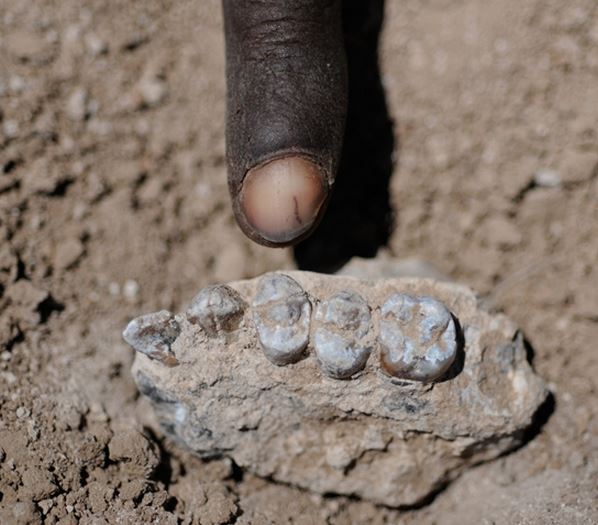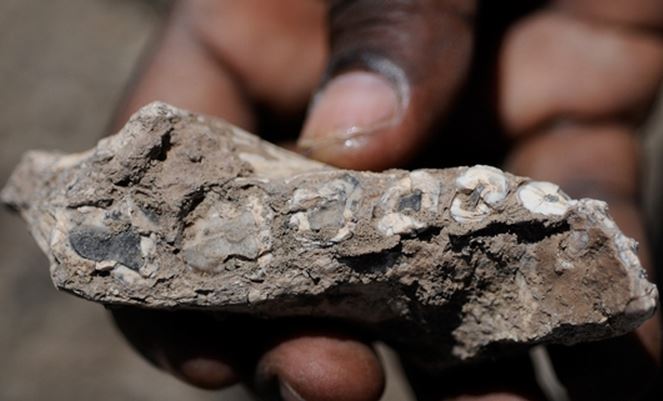A new human ancestor species has been discovered. Called Australopithecus deyiremeda, this hominin lived alongside the famous ‘Lucy’ species 3.3 to 3.5 million years ago. Scientists say perhaps three species co-existed during that period.
Team leader, Dr. Yohannes Haile-Selassie, Curator of Physical Antrhopology at the Cleveland Museum of Natural History, and colleagues wrote about their discovery in the academic journal Nature.
The team recovered upper and lower jaw fossils, from the Woranso-Mille area of the Afar region of Ethiopia, showing the new species combined ape- and human-like traits as did Australopithecus afarensis (Lucy’s species). However, it was sufficiently different to be classified as a separate species, the authors wrote.
 The holotype upper jaw of Australopithecus deyiremeda. (Image: cmnh.org)
The holotype upper jaw of Australopithecus deyiremeda. (Image: cmnh.org)
Two species co-existed
Lucy’s species existed from 2.9 to 3.8 million years ago, which means they overlapped with the new recently-discovered species Australopithecus deyiremeda.
This new find is the most compelling evidence for the contemporaneous existence of more than one closely-related early human ancestor dating back further than 3 million years ago.
The name deyiremeda (pronounced: day-ihreme-dah) means ‘close relative’ in the Afar language.
Australopithecus deyiremeda differs from Australopithecus afarensis in terms of the shape and size of its thick enameled teeth and the robust structure of its lower jaws.
The newly-discovered species probably had a different diet to Lucy’s species, given that its front teeth were smaller.
Maybe three species co-existed
Dr. Haile-Selassie said:
“The new species is yet another confirmation that Lucy’s species, Australopithecus afarensis, was not the only potential human ancestor species that roamed in what is now the Afar region of Ethiopia during the middle Pliocene.”
 The left half of the lower jaw. (Image: cmnh.org)
The left half of the lower jaw. (Image: cmnh.org)
“Current fossil evidence from the Woranso-Mille study area clearly shows that there were at least two, if not three, early human species living at the same time and in close geographic proximity.”
“This new species from Ethiopia takes the ongoing debate on early hominin diversity to another level. Some of our colleagues are going to be skeptical about this new species, which is not unusual.”
“However, I think it is time that we look into the earlier phases of our evolution with an open mind and carefully examine the currently available fossil evidence rather than immediately dismissing the fossils that do not fit our long-held hypotheses.”
Scientists have long believed that between 3 and 4 million years ago there was just one pre-human species at any given time, subsequently giving rise to another new species as time passed.
Fossil records backed this theory until the end of the last century. However, the naming of Kenyanthropus platyops from Kenya and Australopithecus bahrelghazali from Chad, both contemporaries of Lucy’s species, changed everything.
Some scientists continued being skeptical about the validity of these species. Dr. Haile-Selassie’s announcement of the 3.4 million-year old Burtele partial foot in 2012 cleared much of the skepticism.
The Burtele partial fossil foot did not come from Lucy’s species. In spite of the similarity in geological age and close geographic proximity, the scientists have not assigned the partial foot to the new species due to lack of clear association.
Even so, the new species clearly confirms that several species did indeed co-exist during this period.
The Museum wrote on its website:
“This discovery has important implications for our understanding of early hominin ecology. It also raises significant questions, such as how multiple early hominins living at the same time and geographic area might have used the shared landscape and available resources.”
Citation: “New species from Ethiopia further expands Middle Pliocene hominin diversity,” Yohannes Haile-Selassie, Luis Gibert, Stephanie M. Melillo, Timothy M. Ryan, Mulugeta Alene, Alan Deino, Naomi E. Levin, Gary Scott & Beverly Z. Saylor. Nature. Published 27 May, 2015. DOI: 10.1038/nature14448.
Video – New Human Ancestor Species
